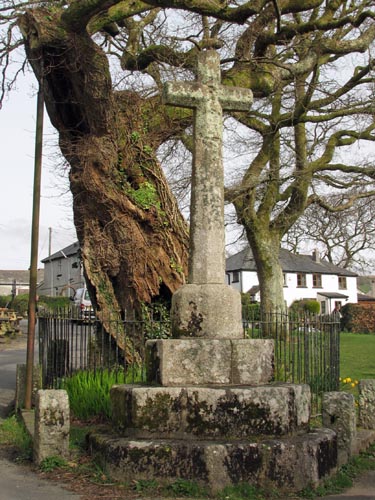 Location:
At the bottom of the village green, under the ancient Meavy Oak tree. Location:
At the bottom of the village green, under the ancient Meavy Oak tree.
O/S Grid Ref: SX/54029/67181 Longitude/Latitude (Degrees+/-): -4.05900/50.48620 Map location: Click here to view map. Purpose: Village Cross. Size: 7 feet 10 inches (2.40 metres) tall. 3 feet (0.90 metres) across the arms. Information: Although the pedestal and socket stone have been in position for hundreds of years, the actual cross was missing until late in the 19th century. The Revd. W.A.G. Gray found the shaft, minus its head and arms, in 1882, incorporated into the churchyard wall. A stonemason, from Walkhampton, made a new head and arms and attached them to the shaft to complete the cross. The Rev. Gray, with help from three local men, Fred Creber and Jack and Richard Bickle, re-erected the cross at its original site on 24th August 1893. It is thought that the cross was originally erected as a preaching cross in the days before the church was built. The cross is set up on a pedestal of three steps, with the original socket stone on the top. These are all octagonal in shape and the socket stone is chamfered towards the top. The cross is also chamfered on all edges and is in generally good condition. The only real flaw being the visible joint where the new head and arms have been fixed onto the shaft. The total height of the pedestal is 4 feet 1inch and the socket stone is a further 1 foot 9 inches high. This raises the total height of the cross to 13 feet 8 inches above the ground. Although this is quite a tall monument, its full effect is diminished by the fact that it is dwarfed by the Meavy Oak, which rises immediately behind it. It is possible that
the Meavy Oak was planted at the same time as the nearby church was built.
This was early in the 12th century, which, if true, would make
the tree almost 900 years old. The trunk is now hollow, and has been so
for well over 150 years, with only 3 segments joining the branches to its The triangular green makes a very picturesque setting to the centre of this ancient village. The edge of the green is surrounded by a series of granite pillars. The village War Memorial is also placed on the green, under the shade of an oak tree. On one side of the green is the village pub, the Royal Oak, below which is the church. On the other side of the green is the village hall and the local primary school is just a short distance up the road. All the amenities are therefore within easy reach of the centre of the village. A further advantage of living in this charming village is that the inn is owned by the parish, which means a share of the profits are used for the benefit of all parishioners. |